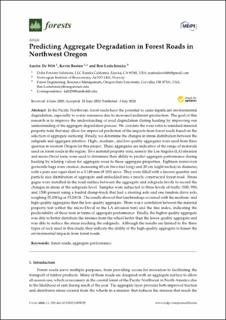| dc.description.abstract | In the Pacific Northwest, forest roads have the potential to cause significant environmental degradation, especially to water resources due to increased sediment production. The goal of this research is to improve the understanding of road degradation during hauling by improving our understanding of the aggregate degradation process. We correlate the wear rates to standard material property tests that may allow for improved prediction of the impacts from forest roads based on the selection of aggregate surfacing. Finally, we determine the changes in stress distribution between the subgrade and aggregate interface. High-, medium-, and low-quality aggregates were used from three quarries in western Oregon for this project. These aggregates are indicative of the range of materials used on forest roads in the region. Two material property tests, namely the Los Angeles (LA) abrasion and micro-Deval tests, were used to determine their ability to predict aggregate performance during hauling by relating values for aggregate wear to these aggregate properties. Eighteen nonwoven geotextile bags were created, measuring 60 cm (two-feet long) and 20 cm (eight inches) in diameter, with a pore size equivalent to a 0.149 mm (# 100) sieve. They were filled with a known quantity and particle size distribution of aggregate and embedded into a newly constructed forest road. Stress gages were installed in the road surface between the aggregate and subgrade levels to record the changes in stress at the subgrade level. Samples were subjected to three levels of traffic (500, 950, and 1500 passes) using a loaded dump-truck that had a steering axle and one tandem drive axle, weighing 25,038 kg or 55,200 lb. The results showed that less breakage occurred with the medium- and high-quality aggregates than the low-quality aggregate. There was a correlation between the material property test (either the micro-Deval or the LA abrasion test) and the fine index, indicating the predictability of these tests in terms of aggregate performance. Finally, the higher quality aggregate was able to better distribute the stresses from the wheel better than the lower quality aggregate and was able to reduce the stress reaching the subgrade. Although the results are limited to the three types of rock used in this study, they indicate the ability of the high-quality aggregate to lessen the environmental impacts from forest roads. | en_US |

